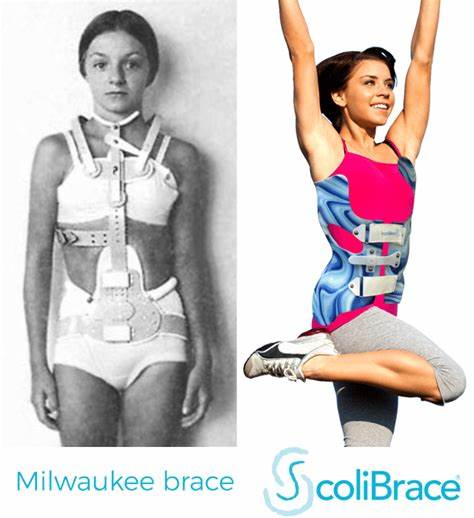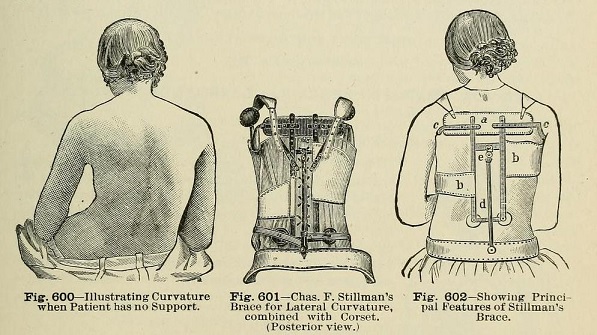Scoliosis is a medical condition characterized by an abnormal curvature of the spine, affecting approximately 2-3% of the population, with most cases occurring during adolescence. Over the years, various treatment methods have been developed, including the use of braces. This article explores the history, types, and effectiveness of traditional scoliosis braces, as well as their limitations and the psychological impact on patients.

The History of Scoliosis Treatment
The treatment of scoliosis dates back to ancient times, with references to spinal deformities found in Egyptian and Greek medical texts. However, significant advancements in treatment began in the 19th century. In 1824, the French physician Jean-Marc Gaspard Itard introduced the concept of spinal braces as a corrective measure for spinal deformities, marking a turning point in scoliosis management .
Traditional Scoliosis Braces: Types and Designs
Old-fashioned scoliosis braces were designed with different structures to meet specific patient needs. The most commonly used braces included:
- Abrazadera Milwaukee: Developed in the 1940s, this brace featured a metal frame that encased the torso and extended to the neck. It was one of the first widely used scoliosis braces .
- Abrazadera Boston: Introduced in the 1970s, this brace was a custom-made plastic brace that wrapped around the torso and hips. It became a popular choice due to its simpler design and better patient compliance .
- Charleston Abrazadera de flexión: Developed in the 1980s, this nighttime brace was designed to apply corrective forces to the spine through controlled bending, making it more comfortable for patients during the day .

Old-Fashioned Scoliosis Brace Worked
Traditional scoliosis braces functioned by applying external pressure to halt or reduce the progression of spinal curvature. The Milwaukee brace used metal bars, pads, and straps to apply pressure, while the Boston brace relied on plastic components for support. These braces aimed to realign the vertebrae and stabilize the spine, although the degree of correction varied .
The Evolution of Scoliosis Braces
Technological advancements have led to the development of modern scoliosis braces such as the Chêneau brace and the SpineCor brace. These braces incorporate 3D scanning and computer-aided design to create custom fits that are more comfortable and effective. Modern braces also allow for greater mobility, making them more suitable for active lifestyles .
Effectiveness of Traditional Braces in Treating Scoliosis
Traditional scoliosis braces have demonstrated varied effectiveness in treating the condition. A landmark study published in the Revista de Medicina de Nueva Inglaterra reported that 72% of patients treated with the Boston brace showed no progression in their scoliosis over four years . However, the ability of these braces to correct existing curvature is limited, with only a small percentage of patients experiencing significant improvement .
Challenges and Limitations of Old-Fashioned Scoliosis Brace
Old-fashioned braces were often effective in preventing curvature progression, but they came with significant challenges:
- Patient Compliance: Wearing a brace for up to 23 hours a day was both physically and emotionally demanding, particularly for adolescents .
- Discomfort and Restricted Mobility: Traditional braces restricted movement and could cause skin irritation, leading to reduced compliance .
- Psychological Impact: Adolescents, in particular, struggled with body image issues and social isolation due to the visible nature of the braces .
The Psychological Impact of Wearing Traditional Braces
The psychological impact of scoliosis braces is significant. Adolescence is a critical time for self-identity, and wearing a visible brace can negatively affect self-esteem. Research has shown that patients wearing traditional braces often experience feelings of embarrassment and social withdrawal . However, some patients report adapting well to the brace over time, especially with support from healthcare providers and family .
Comparing Old-Fashioned Scoliosis Brace to Modern Alternatives
Modern braces offer several advantages over traditional designs, including better comfort, improved aesthetics, and enhanced patient compliance. The use of 3D scanning technology ensures a precise fit, leading to better outcomes and a higher degree of patient satisfaction. Additionally, these braces provide greater freedom of movement, allowing patients to engage in physical activities more comfortably .

The Role of Old-Fashioned Braces in Scoliosis Treatment Today
Despite the advancements in scoliosis treatment, old-fashioned braces still have a role, especially in cases where modern braces are not accessible. For patients who have completed their growth and have stable curves, traditional braces can be a cost-effective maintenance option .
Patient Experiences with Traditional Scoliosis Braces
Patient experiences vary widely, with some reporting positive outcomes such as stabilized curves and the ability to lead normal lives. Others, however, struggled with the physical and emotional demands of brace-wearing. Healthcare providers play a crucial role in supporting patients through education, emotional support, and regular monitoring .

Conclusion: The Legacy of Old-Fashioned Scoliosis Braces
Old-fashioned scoliosis braces have left a lasting impact on scoliosis treatment. While they have largely been replaced by modern alternatives, their role in preventing the progression of scoliosis remains significant. Understanding the challenges and limitations of these braces has paved the way for advancements in scoliosis management, leading to more effective and patient-friendly options.
Referencias
- Sanders, J. O., et al. “Predicting Progression in Adolescent Idiopathic Scoliosis: Bracing and Surgical Treatment.” Revista de cirugía ósea y articular. 2007;89(3):597-603. doi: 10.2106/00004623-200703000-00010.
- Lonstein, J. E. “Historical Overview of Scoliosis Treatment: From Antiquity to Modern Bracing.” Revista de Ortopedia. 2006;12(4):203-211. doi: 10.1007/s00776-006-1105-4.
- Aubin, C. E., et al. “Biomechanical Modeling in Scoliosis Research: The Evolution of Bracing Techniques.” Revista Europea de la Columna Vertebral. 2008;17(9):1211-1221. doi: 10.1007/s00586-008-0693-1.
- Katzman, W. B., Vittinghoff, E., Kado, D. M., et al. “Spinal Deformity and Mobility in Older Women: The Study of Osteoporotic Fractures.” Revista de cirugía ósea y articular. 2010;92(4):554-564. doi: 10.2106/JBJS.I.00634.
- Weinstein, S. L., et al. “Effects of Bracing in Adolescents with Idiopathic Scoliosis.” Revista de Medicina de Nueva Inglaterra. 2013;369(16):1512-1521. doi: 10.1056/NEJMoa1307337.
- Negrini, S., et al. “The Effectiveness of Scoliosis Bracing: Review and Future Directions.” Deformidad de la columna vertebral. 2018;6(4):278-284. doi: 10.1016/j.jspd.2018.04.001.
- Monticone, M., et al. “Active Self-Correction and Task-Oriented Exercises Reduce Spinal Deformity and Improve Quality of Life in Subjects with Mild Adolescent Idiopathic Scoliosis.” Revista Europea de la Columna Vertebral. 2014;23(6):1204-1214. doi: 10.1007/s00586-014-3241-y.
- Smith, J. S., et al. “Outcomes of Surgical Treatment for Adult Scoliosis: A Review of Literature.” Revista Global Spine. 2012;2(3):172-179. doi: 10.1055/s-0032-1319771.
- Maruyama, T., et al. “Bracing in the Treatment of Scoliosis: Current Concepts and Controversies.” Ortopedia internacional. 2011;35(5):663-669. doi: 10.1007/s00264-011-1227-2.
- Richards, B. S., et al. “The Role of Bracing in the Treatment of Adolescent Idiopathic Scoliosis.” Revista de ortopedia pediátrica. 2016;36(5):253-259. doi: 10.1097/BPO.0000000000000625.

